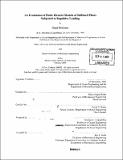An evaluation of finite element models of stiffened plates subjected to impulsive loading
Author(s)
Pedatzur, Omri
DownloadFull printable version (8.629Mb)
Other Contributors
Massachusetts Institute of Technology. Dept. of Mechanical Engineering.
Advisor
Klaus-Jürgen Bathe.
Terms of use
Metadata
Show full item recordAbstract
Different finite element models are evaluated for two very common structures, a cantilever beam and a stiffened plate, subjected to impulsive loading. For the cantilever beam case, the finite element models are one, two or three dimensional models. Various results from the finite element analyses are compared including with analytical solution and a closed-form approximate solution. For the stiffened plate, the models differ from each other by the way the plate and the stiffeners are modeled. Some of the models are very accurate but require much computational resource, while other models are considerably more economic. The purpose of this study was to decide which model is most appropriate for analyzing a ship deck under slamming conditions. The plate modeled with 4-node shell elements and the stiffeners modeled with 2- node iso-beam elements are shown to yield excellent results while requiring reasonable computational resources. In addition to the evaluation of the finite element models, the thesis presents closed- form approximate solutions for both the cantilever beam and the stiffened panel. (cont.) These simplified solutions can be used to check and validate finite element analyses of similar structures. Furthermore, the analytical solutions can be very useful in understanding the basic physical behavior and the main parameters governing the dynamic response of these structures.
Description
Thesis (S.M.)--Massachusetts Institute of Technology, Dept. of Ocean Engineering; and, (S.M.)--Massachusetts Institute of Technology, Dept. of Mechanical Engineering, February 2004. Includes bibliographical references (leaves 88-89).
Date issued
2004Department
Massachusetts Institute of Technology. Department of Mechanical Engineering; Massachusetts Institute of Technology. Department of Ocean EngineeringPublisher
Massachusetts Institute of Technology
Keywords
Ocean Engineering., Mechanical Engineering.